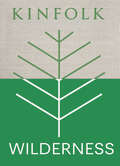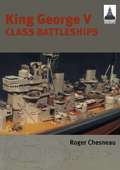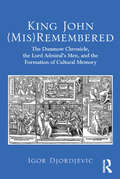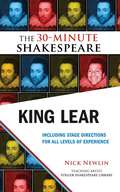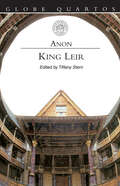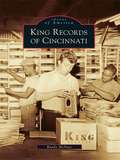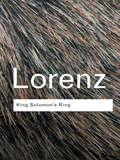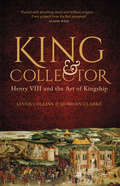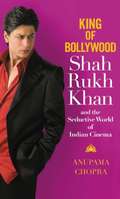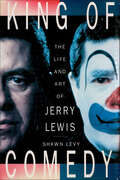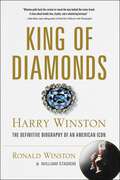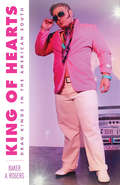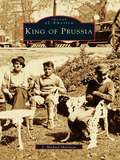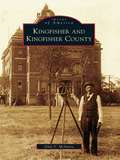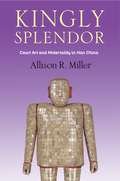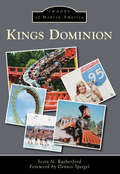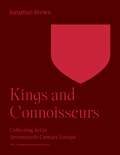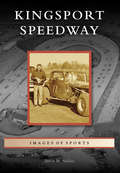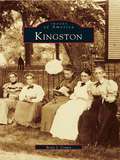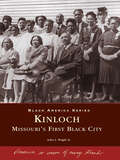- Table View
- List View
Kinfolk Travel: Slower Ways to See the World (Kinfolk)
by John BurnsExplore the art of mindful travel with Kinfolk, the pioneers in &“slow living,&” their philosophy of simplicity, authenticity, intentionality and community. With nearly 450,000 copies in print, the Kinfolk series has applied this philosophy to entertaining (The Kinfolk Table), interior design (The Kinfolk Home), and living with nature (The Kinfolk Garden). Now they have turned their attention to &“slow travel,&” offering readers a road map for planning trips that foster meaningful connections with local people and authentic experiences of local culture. Go museum hopping in Tasmania, or birdwatching in London. Explore the burgeoning fashion community in Dakar. Take a bicycle tour through Idaho, or a train trip from Oslo to Bergen. Drawing on the magazine&’s global community of writers and photographers, Kinfolk Travel takes readers to over 20 location across five continents, with travel tips from locals, stunning images, and thoughtful essays.
Kinfolk Wilderness (Kinfolk Adventures)
by John BurnsThe second volume in the new Kinfolk trilogy (following Kinfolk Islands), which invites readers to celebrate the beauty and possibility to be found in the great outdoors.
King George V Class Battleships (ShipCraft #2)
by Roger ChesneauThe ShipCraft series provides in-depth information about building and modifying model kits of famous warship types. Lavishly illustrated, each book takes the modeller through a brief history of the subject class, highlighting differences between sister-ships and changes in their appearance over their careers. This includes paint schemes and camouflage, featuring colour profiles and highly-detailed line drawings and scale plans. The modelling section reviews the strengths and weaknesses of available kits, lists commercial accessory sets for super-detailing of the ships, and provides hints on modifying and improving the basic kit. This is followed by an extensive photographic gallery of selected high-quality models in a variety of scales, and the book concludes with a section on research references books, monographs, large-scale plans and relevant websites.The five battleships of the class covered by this volume were the most modern British capital ships to serve in the Second World War. They were involved in many famous actions including the sinking of both Bismarck and Scharnhorst, while Prince of Wales suffered the unfortunate distinction of being the first capital ship sunk at sea by air attack.
King John & Henry VIII
by William Shakespeare Jonathan Bate Eric Rasmussen"Mad world, mad kings, mad composition!" --King John In one volume, eminent Shakespearean scholars Jonathan Bate and Eric Rasmussen provide fresh new editions of two classic histories: Henry VIII and King John. THIS VOLUME ALSO INCLUDES MORE THAN A HUNDRED PAGES OF EXCLUSIVE FEATURES: * original Introductions to Henry VIII and King John * incisive scene-by-scene synopses and analyses with vital facts about the works * commentary on past and current productions based on interviews with leading directors, actors, and designers * photographs of key RSC productions * an overview of Shakespeare's theatrical career and chronology of his plays Ideal for students, theater professionals, and general readers, these modern and accessible editions from the Royal Shakespeare Company set a new standard in Shakespearean literature for the twenty-first century.From the Trade Paperback edition.
King John (Mis)Remembered: The Dunmow Chronicle, The Lord Admiral's Men, And The Formation Of Cultural Memory
by Igor DjordjevicKing John’s evil reputation has outlasted and proved more enduring than that of Richard III, whose notoriety seemed ensured thanks to Shakespeare’s portrayal of him. The paradox is even greater when we realize that this portrait of John endures despite Shakespeare’s portrait of him in the play King John, where he hardly comes off as a villain at all. Here Igor Djordjevic argues that the story of John’s transformation in cultural memory has never been told completely, perhaps because the crucial moment in John’s change back to villainy is a literary one: it occurs at the point when the 'historiographic' trajectory of John’s character-development intersects with the 'literary' evolution of Robin Hood. But as Djordjevic reveals, John’s second fall in cultural memory became irredeemable as the largely unintended result of the work of three men - John Stow, Michael Drayton, Anthony Munday - who knew each other and who all read a significant passage in a little known book (the Chronicle of Dunmow), while a fourth man’s money (Philip Henslowe) helped move the story from page to stage. The rest, as they say, is history. Paying particular attention to the work of Michael Drayton and Anthony Munday who wrote for the Lord Admiral’s Men, Djordjevic traces the cultural ripples their works created until the end of the seventeenth century, in various familiar as well as previously ignored historical, poetic, and dramatic works by numerous authors. Djordjevic’s analysis of the playtexts’ source, and the personal and working relationship between the playwright-poets and John Stow as the antiquarian disseminator of the source text, sheds a brighter light on a moment that proves to have a greater significance outside theatrical history; it has profound repercussions for literary history and a nation’s cultural memory.
King Lear: The 30-Minute Shakespeare
by Nick NewlinKing Lear: The 30-Minute Shakespeare renders six powerful scenes from this enduring tragedy. Starting with Lear's banishment of Cordelia, the plot advances irresistibly, featuring scenes of brother Edmund's villainous plotting and the Fool's witty, weighty wordplay.The action climaxes with the storm on the heath, where Lear and Poor Tom rail in exquisite madness. The abridgement concludes with moving scenes of Cordelia's tender reconciliation with King Lear and their heart-rending demise.The edition includes helpful advice by Nick Newlin on how to put on a Shakespeare production in a high school class with novice actors, as well as tips for performing the specific play and recommendations for further resources.
King Leir (Globe Quartos)
by AnonymousPerformed at the Globe Theater in 1605, King Leir is presumed to be a prime source for Shakespeare. Although the story is the same, in this anonymous version the ending is happy. This is the first time this fascinating work is published in a single-play edition
King Records of Cincinnati
by Randy McnuttStarting with a few songs and a dream in 1943, King Records--a leading American independent--launched musical careers from a shabby brick factory on Brewster Avenue in Cincinnati's Evanston neighborhood. Founder Sydney Nathan recorded country singers Cowboy Copas, Hawkshaw Hawkins, Wayne Raney, and others and later added black acts such as James Brown and the Famous Flames, Bull Moose Jackson, Hank Ballard and the Midnighters, Lonnie Johnson, and Freddy King. Meanwhile, King also explored polka, jazz, bluegrass, comedy, gospel, pop, and instrumental music--anything that Nathan could sell. Although King's Cincinnati factory closed in 1971, the company's diverse catalog of roots music had already become a phenomenon. Its legacy lives on in hundreds of classic recordings that are prized by collectors and musicians.
King Solomon's Ring: New Light On Animal Ways (Routledge Classics)
by Konrad LorenzSolomon, the legend goes, had a magic ring which enabled him to speak to the animals in their own language. Konrad Lorenz was gifted with a similar power of understanding the animal world. He was that rare beast, a brilliant scientist who could write (and indeed draw) beautifully. He did more than any other person to establish and popularize the study of how animals behave, receiving a Nobel Prize for his work. King Solomon's Ring, the book which brought him worldwide recognition, is a delightful treasury of observations and insights into the lives of all sorts of creatures, from jackdaws and water-shrews to dogs, cats and even wolves. Charmingly illustrated by Lorenz himself, this book is a wonderfully written introduction to the world of our furred and feathered friends, a world which often provides an uncanny resemblance to our own. A must for any animal-lover!
King and Collector: Henry VIII and the Art of Kingship
by Siobhan Clarke Linda CollinsNo English king is as well-known to us as Henry VIII: famous for six marriages; for dissolving the monasteries; and for the ruthless destruction of those who stood in his way. But Henry was also an ardent patron of the arts whose tapestries and paintings, purchased in pursuit of glory and magnificence, adorned his lavish court and began the Royal Collection. In contrast to later royal collectors, this king was more interested in storytelling than art for its own sake, and all his commissions relate to one central tale: the glorification of Henry and his realm. His life can be seen through his art collection and the works tell us much about both his kingship and his insecurities. King and Collector tells a unique story of art, power and propaganda in Tudor England.
King of Bollywood: Shah Rukh Khan and the Seductive World of Indian Cinema
by Anupama ChopraHere is the astonishing true story of Bollywood, a sweeping portrait about a country finding its identity, a movie industry that changed the face of India, and one man's struggle to become a star. Shah Rukh Khan's larger than life tale takes us through the colorful and idiosyncratic Bollywood movie industry, where fantastic dreams and outrageous obsessions share the spotlight with extortion, murder, and corruption. Shah Rukh Khan broke into this $1.5 billion business despite the fact that it has always been controlled by a handful of legendary film families and sometimes funded by black market money. As a Muslim in a Hindu majority nation, exulting in classic Indian cultural values, Shah Rukh Khan has come to embody the aspirations and contradictions of a complicated culture tumbling headlong into American style capitalism. His story is the mirror to view the greater Indian story and the underbelly of the culture of Bollywood. "A bounty for cinema lovers everywhere." --Mira Nair, Director, The Namesake and Monsoon Wedding "King of Bollywood is the all-singing, all-dancing back stage pass to Bollywood. Anupama Chopra chronicles the political and cultural story of India with finesse and insight, through fly-on-wall access to one of its biggest, most charming and charismatic stars." -- Gurinder Chadha, director of Bend it Like Beckham "The "Easy Rider Raging Bull" of the Bollywood industry and essential reading for any Shah Rukh Khan fan." --Emma Thompson, actress "Anu Chopra infuses the pivotal moments of Shah Rukh Khan's life with an edge-of-your-seat tension worthy of the best Bollywood blockbusters." --Kirkus
King of Comedy: The Life and Art of Jerry Lewis
by Shawn LevyShawn Levy's fascinating biography King of Comedy - the product of vast research and interviews with contemporaries, admirers, foes, and even, briefly, Lewis himself - traces the story of a man who defines High American Show Biz. At points along the time line of his career, Lewis has been the highest-paid performer in history in film, on television, and (in 1995!) on Broadway. With partner Dean Martin, he was half of the most successful comedy duo of all time. He was the first director who debuted in talkies to direct himself. He was a direct, acknowledged influence on giants from Woody Allen to Lenny Bruce to David Letterman to Jim Carrey. He is a Chevalier of the French Legion of Honor, has raised over $1 billion in charity, and was once nominated for a Nobel Peace Prize. And, since the 1950s, he has been one of the most recognized faces on earth. For almost that long, though, people have argued over what Jerry Lewis means. Is he a talented comedian or a grotesque mimic? A startlingly original director or a pretender to Chaplin's throne? A multifaceted entertainer or a megalomaniacal egoist? A tireless champion of the disabled or a tireless self-promoter who has confused America's charitable impulses with affection for him as a performer?
King of Diamonds: Harry Winston, the Definitive Biography of an American Icon
by William Stadiem Ronald WinstonThis authoritative and intimate biography, written by his only living son, Ronald Winston, marries the Gilded Age glamour and romance of Edith Wharton with the ruthless family dynamics of HBO&’s hit series, Succession. Few American success stories rival that of Harry Winston. Born Harry Weinstein, he came from humble roots—his parents were poor Jewish immigrants who left Ukraine around 1890 for New York, where they settled and started a small jewelry business. His genius for spotting priceless gems emerged young. When Harry was twelve years old, he recognized a two-carat emerald in a pawn shop and bought it for 25 cents, selling it two days later for $800—a massive sum in the early 1900s. From that moment on, Harry became obsessed with gems, especially diamonds. A compact, unassuming man with no formal education, but unlimited drive and ambition, Harry Weinstein transformed himself into Harry Winston, the enigmatic figure who created the world&’s most prestigious luxury brand. Harry Winston built his empire while the Depression raged, World War II reshaped the world, and America entered its post-war period of prosperity. In this riveting biography, readers get a bird&’s eye view of the dangers of the diamond trade and the lengths men would go to get their hands on the best of the &“rough.&” There&’s also a glimpse into the lives of the rich and famous, who clamored for Winston&’s gems. Although he traveled the world doing business with kings, queens, and movie stars, Winston remained a devoted family man, whose chief wish was that his sons carry on the legacy he had built. Harry&’s older son Ronald Winston worked alongside his father for decades. After Harry&’s death, Ron grew the company into the international brand that is still revered today. He ran it expertly, until he was forced to sell the company, due to his younger brother&’s maligning litigation. This is the story of a family business that survived and thrived for more than a century, until it was undone by one, bitter family member. KING OF DIAMONDS is at once a portrait of American ingenuity at its best, and the story of sibling rivalry that is Shakespearean in its tragedy.
King of Hearts: Drag Kings in the American South
by Baker A. RogersWhile drag subcultures have gained mainstream media attention in recent years, the main focus has been on female impersonators. Equally lively, however, is the community of drag kings: cis women, trans men, and non-binary people who perform exaggerated masculine personas onstage under such names as Adonis Black, Papi Chulo, and Oliver Clothesoff. King of Hearts shows how drag king performers are thriving in an unlikely location: Southern Bible Belt states like Tennessee, Georgia, and South Carolina. Based on observations and interviews with sixty Southern drag kings, this study reveals how they are challenging the region’s gender norms while creating a unique community with its own distinctive Southern flair. Reflecting the region’s racial diversity, it profiles not only white drag kings, but also those who are African American, multiracial, and Hispanic. Queer scholar Baker A. Rogers—who has also performed as drag king Macon Love—takes you on an insider’s tour of Southern drag king culture, exploring its history, the communal bonds that unite it, and the controversies that have divided it. King of Hearts offers a groundbreaking look at a subculture that presents a subversion of gender norms while also providing a vital lifeline for non-gender-conforming Southerners.
King of Prussia
by J. Michael MorrisonKing of Prussia hosts over 10 million visitors annually. This is quite a change from the little town once described as resembling an English hamlet. By 1762, King of Prussia had already become an area of strategic importance. Only a day's ride from Philadelphia, it was often used as a staging area for travelers heading west.
King of the Tightrope: When the Great Blondin Ruled Niagara
by Donna Janell BowmanIn 1859, The Great Blondin took the most dangerous tightrope walk of his career—a death-defying walk across Niagara Falls. History and STEAM combine for an edge-of-your-seat read. At the age of four, Jean-Francois Gravelet walked across his first balance beam. Later, he took to the tightrope like a spider to its web and climbed toward stardom. Though his feats became more and more marvelous, he grew bored. That is, until he visited Niagara Falls and imagined doing something that no one else had ever accomplished.To cross the raging river, the Great Blondin needed determination, an understanding of engineering, and a belief that what he could imagine, he could accomplish. And in 1859, with all of his preparation complete, Blondin stepped out onto the most dangerous tightrope walk he'd ever faced.Award-winning nonfiction author Donna Janell Bowman uses her trademark in-depth research to give readers a close look at the hard work and meticulous mathematic and scientific planning it took to plan and execute and astonish feat. Adam Gustavson's detailed illustrations turn this book into an experience that will astound and inspire. This fascinating, STEAM-filled story will have readers holding their breath!
Kingdom of Beauty: Mingei and the Politics of Folk Art in Imperial Japan
by Kim BrandtA Study of the Weatherhead East Asian Institute, Columbia University Kingdom of Beauty shows that the discovery of mingei (folk art) by Japanese intellectuals in the 1920s and 1930s was central to the complex process by which Japan became both a modern nation and an imperial world power. Kim Brandt's account of the mingei movement locates its origins in colonial Korea, where middle-class Japanese artists and collectors discovered that imperialism offered them special opportunities to amass art objects and gain social, cultural, and even political influence. Later, mingei enthusiasts worked with (and against) other groups--such as state officials, fascist ideologues, rival folk art organizations, local artisans, newspaper and magazine editors, and department store managers--to promote their own vision of beautiful prosperity for Japan, Asia, and indeed the world. In tracing the history of mingei activism, Brandt considers not only Yanagi Muneyoshi, Hamada Shōji, Kawai Kanjirō, and other well-known leaders of the folk art movement but also the often overlooked networks of provincial intellectuals, craftspeople, marketers, and shoppers who were just as important to its success. The result of their collective efforts, she makes clear, was the transformation of a once-obscure category of pre-industrial rural artifacts into an icon of modern national style.
Kingfisher and Kingfisher County
by Glen V. McintyreKingfisher and Kingfisher County showcases images from a special time, 1889 to just before World War II, and special places, small towns on the edge of the Great Plains. Sometimes called "the Buckle of the Wheat Belt," the city of Kingfisher is the county seat and lies about 45 minutes northwest of Oklahoma City near the center of the state. Other towns, Hennessey, Loyal, Cashion, Dover, and Okarche, still exist and thrive, although many other small towns in the county are only memories. The eastern portion of the county was opened by the land run of 1889, and the western portion, originally part of the Cheyenne and Arapaho Reservation, was opened by the land run of 1892. The growth and harvesting of hard red winter wheat has long been central to the economy of the area. Photographs of Cheyenne Indians, floods, wheat harvesting, small-town stores, and the people of the area are only some of the materials that preserve showing the way life was in Kingfisher and Kingfisher County.
Kingly Splendor: Court Art and Materiality in Han China (Tang Center Series in Early China)
by Allison R. MillerThe Western Han dynasty (202 BCE–9 CE) was a foundational period for the artistic culture of ancient China, a fact particularly visible in the era’s funerary art. Iconic forms of Chinese art such as dazzling suits of jade; cavernous, rock-cut mountain tombs; fancifully ornate wall paintings; and armies of miniature terracotta warriors were prepared for the tombs of the elite during this period. Many of the finest objects of the Western Han have been excavated from the tombs of kings, who administered local provinces on behalf of the emperors.Allison R. Miller paints a new picture of elite art production by revealing the contributions of the kings to Western Han artistic culture. She demonstrates that the kings were not mere imitators of the imperial court but rather innovators, employing local materials and workshops and experimenting with new techniques to challenge the artistic hegemony of the imperial house. Tombs and funerary art, Miller contends, functioned as an important vehicle of political expression as kings strove to persuade the population and other elites of their legitimacy. Through case studies of five genres of royal art, Miller argues that the political structure of the early Western Han, with the emperor as one ruler among peers, benefited artistic production and innovation. Kingly Splendor brings together close readings of funerary art and architecture with nuanced analyses of political and institutional dynamics to provide an interdisciplinary revisionist history of the early Western Han.
Kingman
by Dan W. MessersmithKingman, county seat of Mohave County in northwestern Arizona, owes its beginning and subsequent prosperity to the building of the Atlantic and Pacific Railroad in 1882. The city was named for the project's chief engineer, Lewis Kingman. The initial railroad siding quickly became a supply center for mining and ranching operations that dotted the beautiful surrounding valleys and mountain ranges. Through the years, Kingman has been at the crossroads of rail, highway, and air transportation routes. A B-17 bomber gunnery training base brought changes by exposing the area's potential to thousands of soldiers during World War II, many of whom would later return. Actor Andy Devine grew up here, Clark Gable and Carole Lombard were married here, and Charles Lindbergh would establish a route for Transcontinental Air Transport through here. Today Kingman is the "Heart of Historic U.S. Route 66" and is located in the middle of the longest remaining stretch of the "Mother Road," making it a must-see destination for thousands of tourists each year.
Kings Dominion
by Dennis Speigel Scott N. RutherfordKings Dominion officially opened in 1975 on a 400-acre site between Richmond, Virginia, and Washington, DC. Modeled on sister park Kings Island in Ohio, it debuted with several iconic attractions, including the Eiffel Tower, Rebel Yell, and Lion Country Safari. Over the decades, ownership has changed several times, yet the park continues to grow and remain popular, even "starring" in the 1977 film Rollercoaster. Now celebrating its 40th anniversary, it has evolved into one of North America's premier regional theme parks and is currently home to an impressive assortment of attractions and live entertainment. The park also boasts a formidable arsenal of roller coasters (14), including four of the wooden variety, three LIM-launched coasters, and the 30-story-tall Intimidator (I-305) giga coaster.
Kings and Connoisseurs: Collecting Art in Seventeenth-Century Europe (The A. W. Mellon Lectures in the Fine Arts #43)
by Jonathan BrownA vivid and exciting account of royal collectors, art dealers, connoisseurs, and the rise of old master paintingsOld master paintings are among the most valuable and prestigious of the visual arts, and the best examples command the highest prices of any luxury commodity. In Kings and Connoisseurs, Jonathan Brown tells the story of how painting rose to this exalted status. The transformation of painting from an inexpensive to a costly art form reached a crucial stage in the royal courts of Europe in the seventeenth century, where rulers and aristocrats assembled huge collections, often in short periods of time. By comparing collecting and collectors at these courts, Brown explains the formation of new attitudes toward pictures, as well as the mechanisms that supported the enterprise of collecting, including the emergence of the art dealer, the development of connoisseurship, and the publication of sumptuous picture books of various collections. The result is an exciting narrative of greed and passion, played out against a background of international politics and intrigue.
Kingsport Speedway (Images of Sports)
by David M. McgeeKingsport Speedway has hosted many of racing's greatest drivers, whether its track surface was asphalt, red clay, or brushed concrete. The short track, located in East Tennessee, has undergone dramatic changes since 1965 in attempts to keep pace with an ever-evolving motorsports landscape while entertaining three generations of fans. Hall of Fame members have raced and won at Kingsport Speedway, as did a contingent of regional stars. Today, Kingsport Speedway features weekly programs of NASCAR's Whelen All-American Series, which crowns track, state, regional, and national champions.
Kingston
by Betty J. CotterPerhaps no village in Rhode Island can boast the history of Kingston, or "Little Rest" as it was called. Once a seat of government (its library was one of Rhode Island's five state houses), Kingston has been home to some of the state's most illustrious residents as well as the now sprawling University of Rhode Island. A center of intellectual life long before the university began, Kingston was characterized by social, civic, and dramatic clubs, academies for both men and women, taverns for the weary traveler, and an imposing church atop Kingston Hill whose influence was felt broadly in the village.More than 200 photographs take the reader back tonineteenth-century Kingston, where Stephen Knowles waits atop his carriage to take travelers to Kingston Station, hat maker Cyrus French regales the menfolk in Joe Reynolds's tavern with his expansivestories, and the villagers gather on a summer evening to listen to a musicale on the library's lawn. Within Kingston's pages, the reader can meet people like Solomon Fayerweather, the village blacksmith and church sexton with a unique wisdom about village doings; and Quaker Billy Rose, whose fine weaving work was sought by the likes of Mrs.Theodore Roosevelt. See the familiar, Colonial-style houses that still line Kingstown Road as well as others that have fallen victim to the wrecking ball. Photographs of nearby "Biscuit City" and West Kingston are also included. These photographs, mostly from the collection of the Pettaquamscutt Historical Society, chronicle church, school, and business life in this picturesque village that has played such an important role in Rhode Island's history.
Kinloch: Missouri's First Black City (Black America Series)
by John A. Wright Sr.Located just outside of St. Louis, Kinloch was once a community locked off from the rest of the area by natural and man-made barriers. In spite of a lack of financial resources, it once provided its residents with a school district, city hall, post office, business district, and recreational facilities. Residents will recognize Dunbar Elementary, the oldest school for blacks in St. Louis County, Holy Angels, the oldest continuing black parish in the St. Louis Archdiocese, as well as former residents Congresswoman Maxine Waters and political activist Dick Gregory. Eventually, due to insufficient revenue, this once thriving community fell into decline, and is now struggling to keep its small town values and ideals alive.

